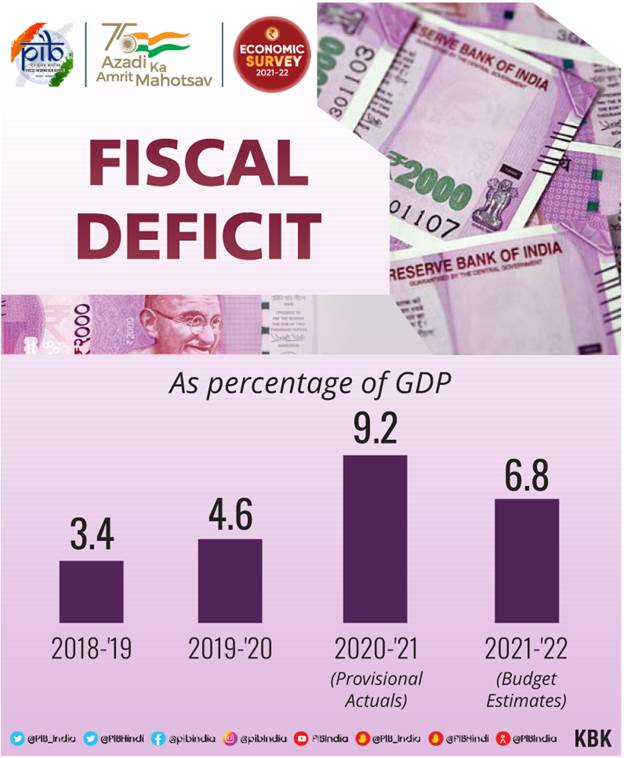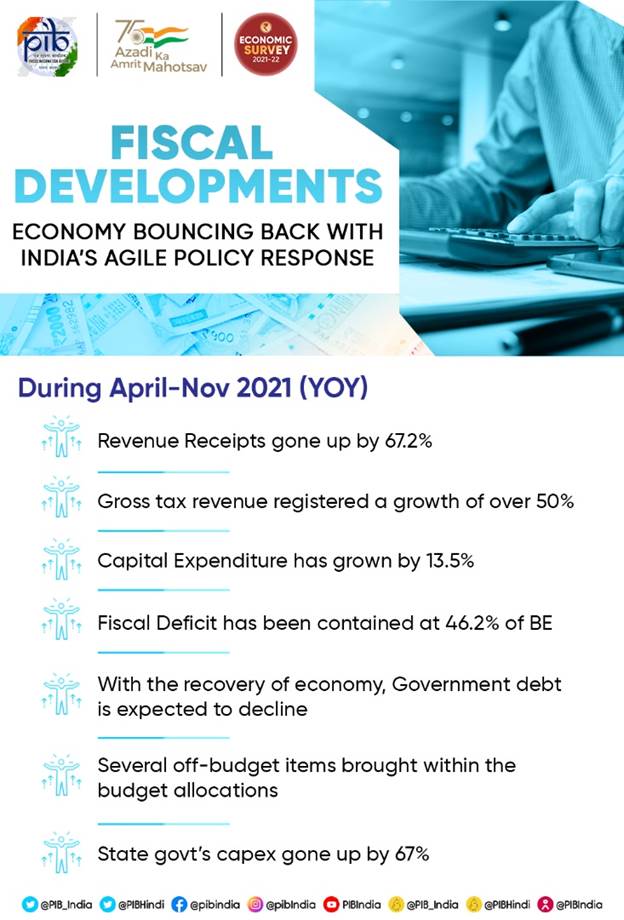Ministry of Finance
FISCAL DEFICIT FOR APRIL TO NOVEMBER 2021 MUCH LOWER IN COMPARISON TO PREVIOUS TWO YEARS
ROBUST GROWTH IN BOTH TAX AND NON-TAX REVENUES DURING APRIL TO NOVEMBER 2021
RESTRUCTURING AND PRIORITIZATION INCREASE GOVERNMENT’S TOTAL EXPENDITURE DURING APRIL TO NOVEMBER 2021
CAPITAL EXPENDITURE REGISTERS 13.5 % GROWTH DURING FIRST THREE QUARTERS OF 2021-22
NEW PUBLIC SECTOR ENTERPRISE POLICY AND ASSET MONETISATION STRATEGY TO BOOST PRIVATIZATION AND DISINVESTMENT
प्रविष्टि तिथि:
31 JAN 2022 2:56PM by PIB Delhi
“In the backdrop of an evolving pandemic situation, Government of India’s agile policy response differed from the waterfall strategy of introducing front-loaded stimulus packages, adopted by most other countries in 2020”, says the Economic Survey 2021-22 tabled by the Union Finance and Corporate Affairs Minister, Smt. Nirmala Sitharaman in the Parliament today. The Economic Survey highlights that in the initial phase of the pandemic, the fiscal policy focused on building safety-nets for the poor and vulnerable sections of society to hedge against the worst-case outcomes. With the restoration of economic activities, the fiscal response focused on stimulating demand in the economy. With the easing of movement and health-related restrictions in Q3 of 2020-21, the capital spending was pushed for encouraging expenditure in sectors with the most positive effect on the economy. Following are the important observations in the Economic Survey 2021-22:
Fiscal Deficit
The data on Government accounts for April to November 2021, released by the Controller General of Accounts, show that the fiscal deficit of the Central Government at end November 2021 stood at 46.2 per cent of the BE compared to 135.1 per cent during the same period in 2020-21 and 114.8 per cent during the same period in 2019-20. During this period both fiscal deficit and primary deficit stood at levels much below the corresponding levels in the previous two years. The primary deficit during the period April to November 2021 turned up at nearly half of the level it had reached during April to November 2019. The fiscal deficit budgeted in the current year was more realistic as it brought in several off-budget items to within the budget allocation such as the food subsidy requirements of FCI.

Revenue collection
Revenue receipts have grown at a much higher pace during the current financial year (April to November 2021) compared to the corresponding periods during the last two years. This performance is attributable to considerable growth in both tax and non-tax revenue. Net tax revenue to the Centre, which was envisaged to grow at 8.5 per cent in 2021-22 BE relative to 2020-21 PA, grew at 64.9 per cent during April to November 2021 over April to November 2020 and at 51.2 per cent over April to November 2019.

Direct Taxes
Within direct taxes, personal income tax has grown at 47.2 per cent over April-November 2020 and at 29.2 per cent over the April-November 2019. The corporate income tax registered a growth of 90.4 per cent over April-November 2020 and 22.5 per cent over April-November 2019.
Indirect Taxes
The indirect tax receipts have registered a YoY growth of 38.6 per cent in the first eight months of this fiscal year. The revenue collection from customs during April to November 2021 has registered a growth of almost 100 per cent over April to November 2020 and over 65 per cent compared to April to November 2019. The revenue from excise duties has registered a YoY growth of 23.2 per cent during April- November 2021. The GST collections for the Centre were 61.4 per cent of BE during April to November 2021. Gross GST collections, Centre and States taken together, were `10.74 lakh crore during April to December 2021, which is an increase of 61.5 per cent over April to December 2020 and 33.7 per cent over April to December 2019.
Non-tax revenue
The non-tax revenue collections up to November 2021 registered an YoY increase of 79.5 per cent. This increase was driven by dividends and profits, which stood at `1.28 lakh crore against BE of `1.04 lakh crore. The key component of dividends and profits during this period was ` 0.99 lakh crore surplus transfer from RBI to the Central Government.
Expenditure
The total expenditure of the Government increased by 8.8 per cent during April to November 2021 and stood at 59.6 per cent of Budget Estimate. While the revenue expenditure has grown by 8.2 per cent during the first eight months of 2021-22 over the same period in 2020-21, the non- interest revenue expenditure grew by 4.6 per cent over April to November 2020.
Capital expenditure
During April to November 2021, capital expenditure registered a growth of 13.5 per cent with focus in infrastructure-intensive sectors like roads and highways, railways, and housing and urban affairs. This increase is particularly substantial given the high YoY growth in capital expenditure registered during the corresponding period of the previous year as well. In addition, the Centre has also put in place several incentives to boost the capital expenditure by the States.
New Public Sector Enterprise Policy and Asset Monetisation Strategy
The New Public Sector Enterprise Policy and Asset Monetisation Strategy introduced by the Government reaffirm its commitment towards privatization and strategic disinvestment of Public Sector Enterprises. The privatisation of Air India has been particularly important, not only in terms of garnering disinvestment proceeds but also for boosting the privatisation drive.
***
RM/YKB/VP
(रिलीज़ आईडी: 1793810)
आगंतुक पटल : 2388